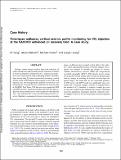| dc.contributor.author | Yang, Di | |
| dc.contributor.author | Fehler, Michael | |
| dc.contributor.author | Huang, Lianjie | |
| dc.contributor.author | Malcolm, Alison E. | |
| dc.date.accessioned | 2015-11-03T18:31:39Z | |
| dc.date.available | 2015-11-03T18:31:39Z | |
| dc.date.issued | 2014-02 | |
| dc.date.submitted | 2013-07 | |
| dc.identifier.issn | 0016-8033 | |
| dc.identifier.issn | 1942-2156 | |
| dc.identifier.uri | http://hdl.handle.net/1721.1/99689 | |
| dc.description.abstract | Geologic carbon storage involves large-scale injections of carbon dioxide into underground geologic formations. Changes in reservoir properties resulting from CO[subscript 2] injection and migration can be characterized using monitoring methods with time-lapse seismic data. To achieve economical monitoring, vertical seismic profile (VSP) data are often acquired to survey the local injection area. We investigated the capability of walkaway VSP monitoring for CO[subscript 2] injection into an enhanced oil recovery field at SACROC, West Texas. VSP data sets were acquired in 2008 and 2009, and CO[subscript 2] injection took place after the first data acquisition. Because the receivers were located above the injection zone, only reflection data contain the information from the reservoir. Qualitative comparison between reverse-time migration images at different times revealed vertical shifts of the reflectors’ center, indicating the presence of velocity changes. We examined two methods to quantify the changes in velocity: standard full-waveform inversion (FWI) and image-domain wavefield tomography (IDWT). FWI directly inverts seismic waveforms for velocity models. IDWT inverts for the time-lapse velocity changes by matching the baseline and time-lapse migration images. We found that, for the constrained geometry of VSP surveys, the IDWT result was significantly more consistent with a localized change in velocity as expected from a few months of CO[subscript 2] injection. A synthetic example was used to verify the result from the field data. By contrast, FWI failed to provide quantitative information about the volumetric velocity changes because of the survey geometry and data frequency content. | en_US |
| dc.language.iso | en_US | |
| dc.publisher | Society of Exploration Geophysicists | en_US |
| dc.relation.isversionof | http://dx.doi.org/10.1190/GEO2013-0274.1 | en_US |
| dc.rights | Article is made available in accordance with the publisher's policy and may be subject to US copyright law. Please refer to the publisher's site for terms of use. | en_US |
| dc.source | Society of Exploration Geophysicists | en_US |
| dc.title | Time-lapse walkaway vertical seismic profile monitoring for CO[subscript 2] injection at the SACROC enhanced oil recovery field: A case study | en_US |
| dc.type | Article | en_US |
| dc.identifier.citation | Yang, Di, Alison Malcolm, Michael Fehler, and Lianjie Huang. “Time-Lapse Walkaway Vertical Seismic Profile Monitoring for CO[subscript 2] Injection at the SACROC Enhanced Oil Recovery Field: A Case Study.” GEOPHYSICS 79, no. 2 (March 2014): B51–B61. © 2014 Society of Exploration Geophysicists | en_US |
| dc.contributor.department | Massachusetts Institute of Technology. Department of Earth, Atmospheric, and Planetary Sciences | en_US |
| dc.contributor.department | Massachusetts Institute of Technology. Earth Resources Laboratory | en_US |
| dc.contributor.mitauthor | Yang, Di | en_US |
| dc.contributor.mitauthor | Malcolm, Alison E. | en_US |
| dc.contributor.mitauthor | Fehler, Michael | en_US |
| dc.relation.journal | Geophysics | en_US |
| dc.eprint.version | Final published version | en_US |
| dc.type.uri | http://purl.org/eprint/type/JournalArticle | en_US |
| eprint.status | http://purl.org/eprint/status/PeerReviewed | en_US |
| dspace.orderedauthors | Yang, Di; Malcolm, Alison; Fehler, Michael; Huang, Lianjie | en_US |
| dc.identifier.orcid | https://orcid.org/0000-0002-8814-5495 | |
| mit.license | PUBLISHER_POLICY | en_US |
| mit.metadata.status | Complete | |
